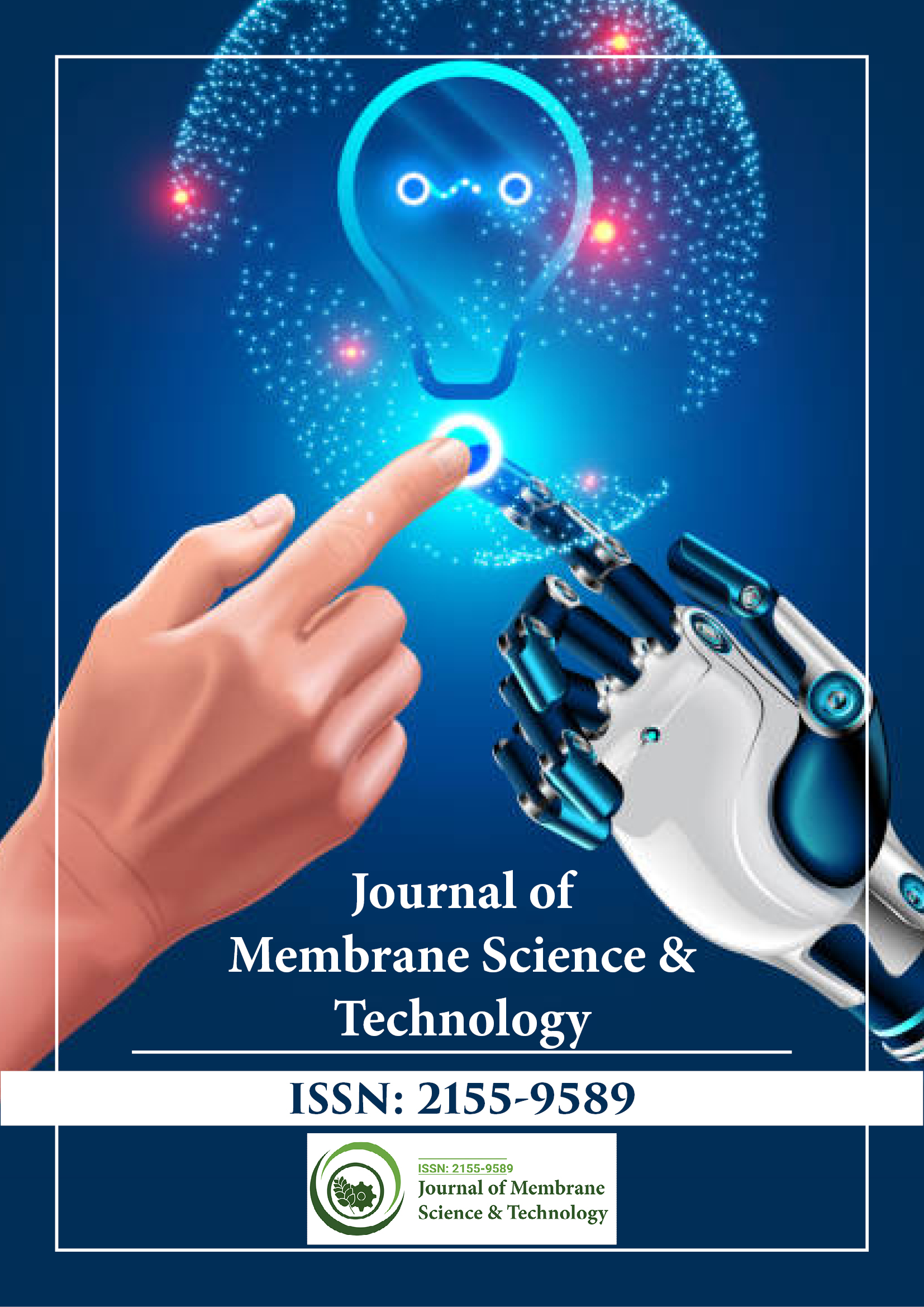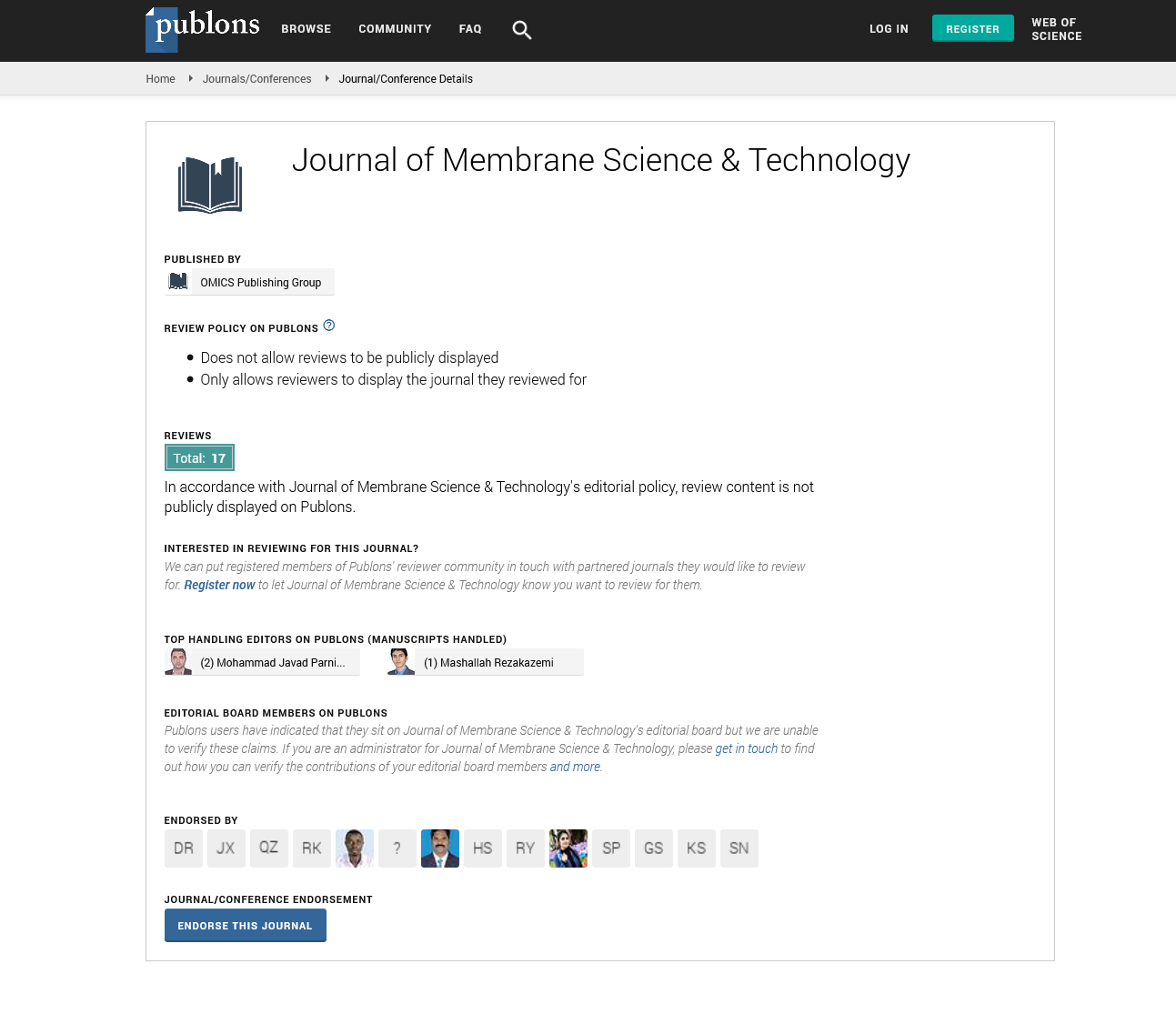Indexed In
- Open J Gate
- Genamics JournalSeek
- Ulrich's Periodicals Directory
- RefSeek
- Directory of Research Journal Indexing (DRJI)
- Hamdard University
- EBSCO A-Z
- OCLC- WorldCat
- Proquest Summons
- Scholarsteer
- Publons
- Geneva Foundation for Medical Education and Research
- Euro Pub
- Google Scholar
Useful Links
Share This Page
Journal Flyer

Open Access Journals
- Agri and Aquaculture
- Biochemistry
- Bioinformatics & Systems Biology
- Business & Management
- Chemistry
- Clinical Sciences
- Engineering
- Food & Nutrition
- General Science
- Genetics & Molecular Biology
- Immunology & Microbiology
- Medical Sciences
- Neuroscience & Psychology
- Nursing & Health Care
- Pharmaceutical Sciences
Perspective - (2025) Volume 15, Issue 1
Membrane Filtration Technology: A Modern Approach to Water and Wastewater Treatment
Danqi Huang*Received: 31-Jan-2025, Manuscript No. JMST-25-29280; Editor assigned: 03-Feb-2025, Pre QC No. JMST-25-29280 (PQ); Reviewed: 17-Feb-2025, QC No. JMST-25-29280; Revised: 24-Feb-2025, Manuscript No. JMST-25-29280 (R); Published: 03-Mar-2025, DOI: 10.35248/2155-9589.25.15.416
Description
Membrane filtration has emerged as a transformative technology in the field of liquid purification, particularly in water and wastewater treatment. This method utilizes semi-permeable membranes to separate particles, microorganisms and dissolved substances from fluids, offering a clean, efficient and environmentally sound approach to fluid management. The core principle behind membrane filtration lies in forcing a liquid through a selective barrier under pressure, allowing only specific molecules, such as water or small solutes, to pass while retaining larger contaminants. This selective separation is determined by the membrane’s pore size and material properties, making it highly adaptable to various industrial and environmental applications.
Unlike conventional treatment methods that often rely on heavy chemical use or energy-intensive processes, membrane filtration achieves high levels of purification with minimal chemical additives. This not only enhances environmental sustainability but also ensures the preservation of sensitive compounds in processes such as food production and pharmaceutical manufacturing. The technology spans several distinct filtration types, each defined by its pore size and the kind of substances it is designed to remove. Microfiltration, with the largest pores, is suitable for removing bacteria and suspended solids and is commonly used in drinking water production and beverage clarification. Ultrafiltration, which features smaller pores, effectively retains viruses, proteins and colloids and is often employed in pharmaceutical and food industries. Nano filtration provides an intermediate level of filtration, removing small organic compounds and divalent salts, making it ideal for applications like water softening and color removal. The most refined process, reverse osmosis, filters out even the smallest particles, including dissolved salts and heavy metals and is widely used for desalination and producing high-purity water.
The effectiveness of membrane filtration systems depends not only on the membranes themselves but also on the supporting components that make up a complete system. These systems typically include a feed pump to supply the necessary pressure, membrane modules configured in various formats such as spiralwound or hollow fiber, pressure vessels and a network of pipes to guide fluid flow. In addition, monitoring equipment is used to track operational parameters like pressure, flow rate, and the quality of the filtered water, allowing for precise control and optimization.
One of the major advantages of membrane filtration is its ability to deliver consistent and high-quality results. The systems are compact and space-efficient, making them particularly suitable for both urban installations and decentralized applications. They can be scaled up or down to meet the needs of a household, a factory, or a municipal water treatment facility. Membrane systems are also highly flexible, allowing for easy customization based on specific treatment goals or local water quality issues. Their modular nature means that expanding capacity or upgrading performance often requires minimal structural changes.
However, like any advanced technology, membrane filtration is not without its challenges. A primary concern is membrane fouling, where particles or biological matter accumulate on the membrane surface, reducing efficiency and lifespan. This necessitates regular cleaning and maintenance, which can be resource-intensive. Operational costs may also be higher due to the energy required to maintain pressure and the periodic need to replace membranes. Furthermore, the raw water must often undergo pretreatment to remove substances that could damage the membranes or hasten fouling. Another consideration is the disposal of the concentrated waste stream, known as retentate, which must be managed responsibly to avoid environmental harm.
Despite these limitations, membrane filtration continues to find widespread applications across multiple sectors. In municipal water treatment, it ensures safe drinking water and enables water reuse programs aimed at conservation. In the food and beverage industry, it is used to clarify juices, separate milk components and purify ingredients without affecting flavor or nutritional content. The pharmaceutical sector relies on membrane processes for sterilizing liquids, separating sensitive biological materials and producing ultra-pure water for drug formulation. Even the electronics industry uses membrane-treated water for the delicate processes involved in semiconductor manufacturing, where any contamination can compromise product quality.
Continuous innovation is driving the evolution of membrane technology, making it more efficient, cost-effective and durable. New materials are being developed to resist fouling and scaling, while system designs are being optimized to consume less energy. Hybrid systems that combine membrane filtration with other treatment methods such as ultraviolet light, advanced oxidation processes, or adsorption offer enhanced performance and broader contaminant removal. Additionally, the integration of digital sensors and artificial intelligence enables real-time monitoring and predictive maintenance, ensuring optimal performance and reducing downtime.
Conclusion
In summary, membrane filtration stands at the forefront of modern fluid treatment technologies, offering a versatile, precise and sustainable solution to pressing global challenges in water quality, environmental stewardship and industrial processing. While it faces operational and economic hurdles, ongoing research and development are steadily improving its practicality and effectiveness. As the demand for clean water and sustainable industrial processes continues to grow, membrane filtration is poised to play an increasingly central role in shaping a healthier and more resilient future.
Citation: Huang D (2025). Membrane Filtration Technology: A Modern Approach to Water and Wastewater Treatment. J Membr Sci Technol. 15:416.
Copyright: © 2025 Huang D. This is an open-access article distributed under the terms of the Creative Commons Attribution License, which permits unrestricted use, distribution, and reproduction in any medium, provided the original author and source are credited.

